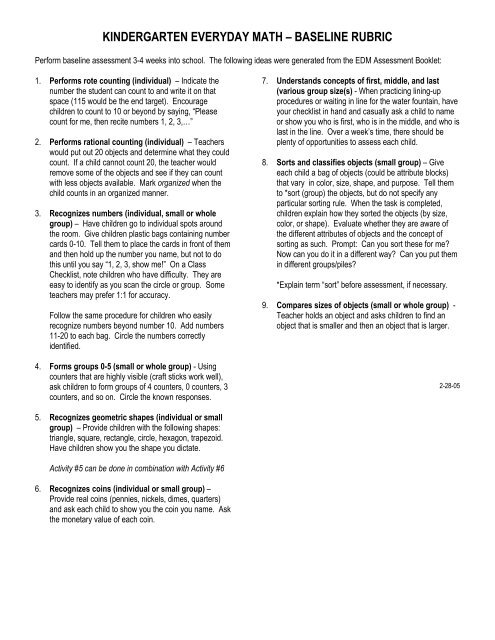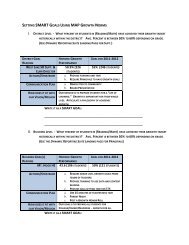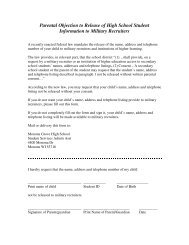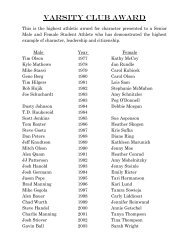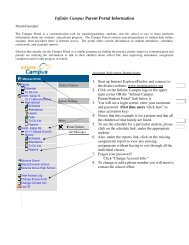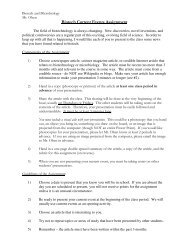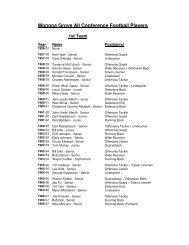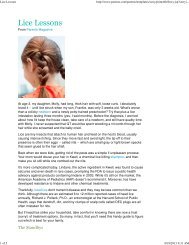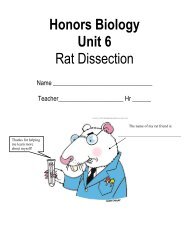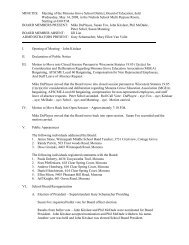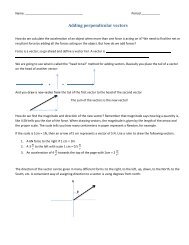KINDERGARTEN EVERYDAY MATH – BASELINE RUBRIC
kindergarten everyday math â baseline rubric - Monona Grove ...
kindergarten everyday math â baseline rubric - Monona Grove ...
Create successful ePaper yourself
Turn your PDF publications into a flip-book with our unique Google optimized e-Paper software.
<strong>KINDERGARTEN</strong> <strong>EVERYDAY</strong> <strong>MATH</strong> <strong>–</strong> <strong>BASELINE</strong> <strong>RUBRIC</strong><br />
Perform baseline assessment 3-4 weeks into school. The following ideas were generated from the EDM Assessment Booklet:<br />
1. Performs rote counting (individual) <strong>–</strong> Indicate the<br />
number the student can count to and write it on that<br />
space (115 would be the end target). Encourage<br />
children to count to 10 or beyond by saying, “Please<br />
count for me, then recite numbers 1, 2, 3,…”<br />
2. Performs rational counting (individual) <strong>–</strong> Teachers<br />
would put out 20 objects and determine what they could<br />
count. If a child cannot count 20, the teacher would<br />
remove some of the objects and see if they can count<br />
with less objects available. Mark organized when the<br />
child counts in an organized manner.<br />
3. Recognizes numbers (individual, small or whole<br />
group) <strong>–</strong> Have children go to individual spots around<br />
the room. Give children plastic bags containing number<br />
cards 0-10. Tell them to place the cards in front of them<br />
and then hold up the number you name, but not to do<br />
this until you say “1, 2, 3, show me!” On a Class<br />
Checklist, note children who have difficulty. They are<br />
easy to identify as you scan the circle or group. Some<br />
teachers may prefer 1:1 for accuracy.<br />
Follow the same procedure for children who easily<br />
recognize numbers beyond number 10. Add numbers<br />
11-20 to each bag. Circle the numbers correctly<br />
identified.<br />
4. Forms groups 0-5 (small or whole group) - Using<br />
counters that are highly visible (craft sticks work well),<br />
ask children to form groups of 4 counters, 0 counters, 3<br />
counters, and so on. Circle the known responses.<br />
7. Understands concepts of first, middle, and last<br />
(various group size(s) - When practicing lining-up<br />
procedures or waiting in line for the water fountain, have<br />
your checklist in hand and casually ask a child to name<br />
or show you who is first, who is in the middle, and who is<br />
last in the line. Over a week’s time, there should be<br />
plenty of opportunities to assess each child.<br />
8. Sorts and classifies objects (small group) <strong>–</strong> Give<br />
each child a bag of objects (could be attribute blocks)<br />
that vary in color, size, shape, and purpose. Tell them<br />
to *sort (group) the objects, but do not specify any<br />
particular sorting rule. When the task is completed,<br />
children explain how they sorted the objects (by size,<br />
color, or shape). Evaluate whether they are aware of<br />
the different attributes of objects and the concept of<br />
sorting as such. Prompt: Can you sort these for me?<br />
Now can you do it in a different way? Can you put them<br />
in different groups/piles?<br />
*Explain term “sort” before assessment, if necessary.<br />
9. Compares sizes of objects (small or whole group) -<br />
Teacher holds an object and asks children to find an<br />
object that is smaller and then an object that is larger.<br />
2-28-05<br />
5. Recognizes geometric shapes (individual or small<br />
group) <strong>–</strong> Provide children with the following shapes:<br />
triangle, square, rectangle, circle, hexagon, trapezoid.<br />
Have children show you the shape you dictate.<br />
Activity #5 can be done in combination with Activity #6<br />
6. Recognizes coins (individual or small group) <strong>–</strong><br />
Provide real coins (pennies, nickels, dimes, quarters)<br />
and ask each child to show you the coin you name. Ask<br />
the monetary value of each coin.
<strong>KINDERGARTEN</strong> <strong>EVERYDAY</strong> <strong>MATH</strong> <strong>–</strong> 1 ST TRIMESTER<br />
The following ideas were generated from the EDM Assessment Booklet:<br />
1.<br />
Performs rote counting (individual) <strong>–</strong> Indicate the number<br />
the student can count to and write it on that space (115<br />
would be the end target). Encourage children to count to<br />
10 or beyond by saying, “Please count for me, then recite<br />
numbers 1, 2, 3,…”<br />
2. Counts back (individual) <strong>–</strong> Ask child to count backwards<br />
from 10-0. Mark beginning if child does not attempt to<br />
count backwards; developing if child is mixed up a bit in<br />
his/her counting; and secure if children can count<br />
backwards 10-0.<br />
3. Read numbers (individual) <strong>–</strong> Present numbers 0-20 in<br />
random order to child. Ask the child to attempt to read as<br />
many numbers as he/she can.<br />
Add numbers 21-35 for children who can easily read<br />
numbers beyond number 20.<br />
5. Recognize a penny and know its value (individual) <strong>–</strong><br />
Show a penny to the child and ask if they know the name<br />
of the coin and its monetary value.<br />
6. Performs rational counting (individual) <strong>–</strong> Teachers<br />
displays 20 objects and asks the child to count the<br />
number of objects. If a child cannot count 20, the teacher<br />
would remove some of the objects and see if they can<br />
count with less objects available. Mark organized when<br />
the child counts in an organized manner.<br />
7. Recognizes geometric shapes (individual) <strong>–</strong> Provide<br />
children with the following shapes: triangle, square,<br />
rectangle, and circle. Have child attempt to name the<br />
shapes. If the child cannot name the shape, ask him/her<br />
to show you the shape you dictate.<br />
4. Compare lengths, matching ends (small group) <strong>–</strong> In a<br />
designated area, place varying lengths of tape on the<br />
floor. Give child color-coded paper strips to match the<br />
lengths of the tape.<br />
2-28-05
<strong>KINDERGARTEN</strong> <strong>EVERYDAY</strong> <strong>MATH</strong> <strong>–</strong> 2nd TRIMESTER<br />
The following ideas were generated from the EDM Assessment Booklet:<br />
1. Recognize simple examples of symmetry (individual<br />
or small group) <strong>–</strong> Show 5 pictures/objects <strong>–</strong> some with<br />
symmetry and some without symmetry. Can they identify<br />
pictures/objects with symmetry? Can they identify nonsymmetrical<br />
pictures/objects.<br />
2. Performs rote counting) (individual) <strong>–</strong> Indicate the<br />
number the student can count to and write it on that<br />
space (115 would be the end target). Encourage children<br />
to count to 10 or beyond by saying, “Please count for me,<br />
then recite numbers 1, 2, 3,…”<br />
3. Counts back (individual) <strong>–</strong> Ask child to count<br />
backwards from 15-0. Mark beginning if child cannot<br />
attempt to count backwards; developing if child are mixed<br />
up a bit in their counting; and secure if child can count<br />
backwards 15-0.<br />
4. Continues counting varying the starting point (whole<br />
group) <strong>–</strong> Start with any number other than 0 or 1, and<br />
ask the child to count to some specified number.<br />
Observe abilities both to reach and stop at the target<br />
number without prompting.<br />
5. Writes numbers 0-15 (small or whole group) <strong>–</strong> Ask<br />
children to write and display on their slates particular<br />
numbers as part of a group lesson; for example, “Write<br />
the number 12. 1, 2, 3, show me!”<br />
9. Draw tally marks 1-5 (whole group) - Teacher shows 5<br />
objects. Ask children to mark on individual sheets or<br />
slates how many objects they see. Mark secure if child’s<br />
tally shows a diagonal line through 4 straight lines.<br />
10. Tells an addition number story (whole group or<br />
individual) <strong>–</strong> After several sessions involving groupdeveloped<br />
number stories, begin encouraging children to<br />
develop their own stories to share with the group. The<br />
purpose is to see if children are able to tell simple<br />
number stories.<br />
11. Names and identifies coins (individual) <strong>–</strong> Provide real<br />
coins (pennies, nickels, dimes, quarters) and ask each<br />
child to show you the coin you name. Ask if they know<br />
the monetary value of each.<br />
12. Skip counts by 2’s to 20 (individual)<br />
13. Skip counts by 5’s to 50 (individual)<br />
14. Skip counts by 10’s to 100 (individual)<br />
2-28-05<br />
6. Generates and continues an AB pattern (small or<br />
whole group) <strong>–</strong> Observe children as they complete one<br />
of the pattern activities in the Teacher’s Guide to<br />
Activities, such as Class Patterning, page 102, or Follow<br />
My Pattern, page 103.<br />
7. Understands “teen” numbers as 10+ a digit<br />
(individual) <strong>–</strong> Provide students with 3 bundles (of 10)<br />
and 20 single straws. Ask child to show you 13 straws,<br />
then 17 straws. Mark secure if the child shows you 1<br />
bundle of 10 and the correct number of single straws for<br />
both of the numbers you gave them (13, 17). Mark<br />
beginning if the child gives you the wrong number of<br />
single straws. Mark developing if the child gives you any<br />
remaining combination of answers.<br />
8. Interprets a graph (individual, small or whole group)<br />
Show students a graph that is unfamiliar to them and ask<br />
which row has the most, least, and if there are any equal<br />
amounts.
<strong>KINDERGARTEN</strong> <strong>EVERYDAY</strong> <strong>MATH</strong> <strong>–</strong> 3rd TRIMESTER<br />
The following ideas were generated from the EDM Assessment Booklet:<br />
1. Performs rote counting (individual) <strong>–</strong> Indicate the<br />
number the student can count to and write it on that space<br />
(115 is the end target). Encourage child to count to 10 or<br />
beyond by saying, “Please count for me, then recite<br />
numbers 1, 2, 3,…”<br />
2. Counts back (individual) <strong>–</strong> Ask child to count backwards<br />
from 20-0. Mark beginning if child cannot attempt to count<br />
backwards; developing if child are mixed up a bit in their<br />
counting; and secure if child can count backwards 20-0.<br />
3. Continues counting varying the starting point<br />
(individual) <strong>–</strong> Start with 85 and ask the child to count to<br />
some specified number (e.g., 115). Observe abilities both<br />
to reach and stop at the target number without prompting.<br />
8. Skip counts by 2’s to 32 (individual)<br />
9. Skip counts by 5’s to 115 (individual)<br />
10. Skip counts by 10’s to 120 (individual)<br />
11. Reads time (individual) <strong>–</strong> Teacher has a display clock,<br />
sets a time and asks child to name the hours. Set hours<br />
at 3, 6, and 9.<br />
2-28-05<br />
4. Reads any number 0-100 (individual) <strong>–</strong> Show child 10<br />
different numbers, point to a number and ask him/her to<br />
recite the number to you. Mark beginning if the child can<br />
read numbers between 0-20. Mark developing if the child<br />
can read numbers between 0-75. Mark secure if the child<br />
can name all 10 numbers.<br />
Writes any number 0-100 (small or large group or<br />
individual?) <strong>–</strong> Dictate 10 different numbers to children to<br />
write on their slates, e.g., “Write the number 12, 1, 2, 3,<br />
show me!” Mark beginning if the child can write numbers<br />
between 0-20. Mark developing if the child can write<br />
numbers between 0-75. Mark secure if the child can write<br />
all 10 numbers.<br />
11. Generates and continues a 3-part pattern (small or<br />
whole group) <strong>–</strong> Observe children as they complete one of<br />
the pattern activities in the Teacher’s Guide to Activities,<br />
such as Class Patterning, page 102, or Follow My Pattern,<br />
page 103 (e.g., ABC, ABB, AAB).<br />
12. Tells a subtraction number story (whole group or<br />
individual) <strong>–</strong> After several sessions involving groupdeveloped<br />
number stories, begin encouraging children to<br />
develop their own stories to share with the group. The<br />
purpose is to see if children are able to tell simple number<br />
stories.<br />
7. Names and identifies coins (individual) <strong>–</strong> Provide real<br />
coins (pennies, nickels, dimes, quarters) and ask each<br />
child to show you the coin you name. Ask if they know the<br />
monetary value of each.


